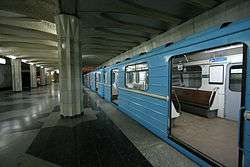Tashkent Metro
 | |||
 | |||
| Overview | |||
|---|---|---|---|
| Native name |
Toshkent Metropoliteni Ташкентский Метрополитен | ||
| Owner | State ownership | ||
| Locale | Tashkent, Uzbekistan | ||
| Transit type | Rapid transit | ||
| Number of lines | 3[1] | ||
| Number of stations | 29[1] | ||
| Daily ridership | 162,200 (average, 2013) | ||
| Annual ridership | 59.2 million (2013)[1] | ||
| Operation | |||
| Began operation | 1977 | ||
| Operator(s) | Toshkent Metropoliteni | ||
| Number of vehicles | 168[1] | ||
| Train length | 4 cars | ||
| Technical | |||
| System length | 36.2 km (22.5 mi)[1] | ||
| Track gauge | 1,524 mm (5 ft) | ||
| Electrification | 825 V DC (third rail) | ||
| Average speed | 46 km/h (29 mph) | ||
| |||
The Tashkent Metro (Uzbek: ''Toshkent metropoliteni'') is the rapid transit system serving the city of Tashkent, the capital of Uzbekistan. It is one of only two subway systems currently operating in Central Asia (the other one being the Almaty Metro). It was the seventh metro to be built in the former USSR, opening in 1977. Its stations are among the most ornate in the world. Unlike most of the ex-Soviet metros, the system is shallow (similar to the Minsk Metro).
The Tashkent Metro consists of three lines, operating on 36.2 kilometres (22.5 mi) of route and serving 29 stations.[1] In 2013, the metro carried 59.2 million passengers,[1] which corresponds to a daily average of approximately 162,200 riders.
History
Planning for the Tashkent Metro started in 1968, two years after a major earthquake struck the city in 1966. Construction on the first line began in 1972 and it opened on November 6, 1977 with nine stations. This line was extended in 1980, and the second line was added in 1984. The most recent line is the Yunusobod Line, the first section of which opened in 2001.
A northern extension of this line is currently under construction, and a fourth line was to start construction in 2010, but has been delayed.
Operations
System
The Tashkent Metro comprises three lines which operate on 36.2 kilometres (22.5 mi) of route and serve 29 stations.[1]
The depth of the metro's underground tunnels varies between 8–25 metres (26–82 ft). The strong construction of these three lines can resist earthquakes of a magnitude of 9.0 on the Richter scale.[2] It sports a 1,524 mm (5 ft) gauge and a third rail power supply (825 V DC). The average station distance is 1.40 kilometres (0.87 mi).
Lines

- Current lines
| # | Name | Opened | Length | Stations |
|---|---|---|---|---|
| 1 | Chilonzor Line | 1977 | 15.5 km | 12 |
| 2 | Oʻzbekiston Line | 1984 | 14.3 km | 11 |
| 3 | Yunusobod Line | 2001 | 6.4 km | 6 |
| TOTAL: | 36.2 km | 29 | ||
The details of each line is as follows:
Chilonzor Line (red): Construction on this line started in 1968, opened in 1977 between Sabir Rakhimov and Oktyabrinkilobi (Russian: Oktyabr'skoy Revolyutsii, now Amir Temur Khiyoboni) including Novza (Khamza) depot and one metro bridge over Oqtepa channel between Novza (Khamza) and Komsomolskaya stations. It was extended to Maksim Gor'kiy (now Buyuk Ipak Yoli) in 1980 (including another metro bridge over Salar river between Hamid Alimdzhan and Pushkin stations). It is 15.5 kilometres (9.6 mi) long with 12 stations - the planned eastward extension to Traktornyi Zavod (3 stations) was under way but now has disappeared from maps.
Uzbekiston Line (blue): The route of this line crosses the city diagonally from northwest to southeast via the Toshkent Railway station. It opened in 1984 and expanded between 1984 and 1991. It is 14.3 kilometres (8.9 mi) long with 11 stations.
Yunusobod Line (green): Work is under way on this line to connect the northern districts to the airport in the south. The first 6.4 kilometres (4 mi) section with six underground stations opened for regular service on 24 Oct 2001 (test runs began on 28 August 2001 - the 10th anniversary of independence, but opening was delayed due to 9/11 attacks) between Ming Urik (initially planned to be named Lokhutiy) and Habib Abdullayev (initially planned to be named Shahriston).
- Planned lines
| # | Name | Opened | Length | Stations |
|---|---|---|---|---|
| 4 | Sirghali Line | proposed | ||
Stations
Today, the Tashkent Metro has 29 stations that differ from each other. The architecture and décor of each station depicts its name. The peculiarity of the Tashkent metro is its rather shallow station positioning. Some stations have escalators, 7 stations belong to the tower type, 4 stations to the arch type and one station (Mustakillik) to the tower-individual type. Prominent architects and artists of Uzbekistan took part in designing the stations. Interior décor features solid and stable materials: metal (in the form of engravings), glass, plastic, granite, marble, smalt, art ceramics, and carved alabaster. Each station is original work of art and centers on a particular theme.
Rolling stock

As of 2013, there are 168 81-717/714 train cars operational on the metro,[1] and they are operated in the form 4-car trainsets serving the system's 100 metres (330 ft) station platforms. Trains have an average commercial speed of 46 kilometres per hour (29 mph).
Rules and restrictions
It is illegal to take pictures inside the metro system or any of the stations because they are considered military installations.
See also
References
- 1 2 3 4 5 6 7 8 9 ОСНОВНЫЕ ТЕХНИКО-ЭКСПЛУАТАЦИОННЫЕ ХАРАКТЕРИСТИКИ МЕТРОПОЛИТЕНОВ ЗА 2013 ГОД. [Main technical and operational specifications for Subways for Year 2013.] (pdf). asmetro.ru (in Russian). Международная Ассоциация "Метро" [International Association of Metros]. 2013. pp. 1,3. Retrieved 2014-05-13.
- ↑ Горизонт - информационно-аналитический сайт
External links
| Wikimedia Commons has media related to Tashkent Metro. |

